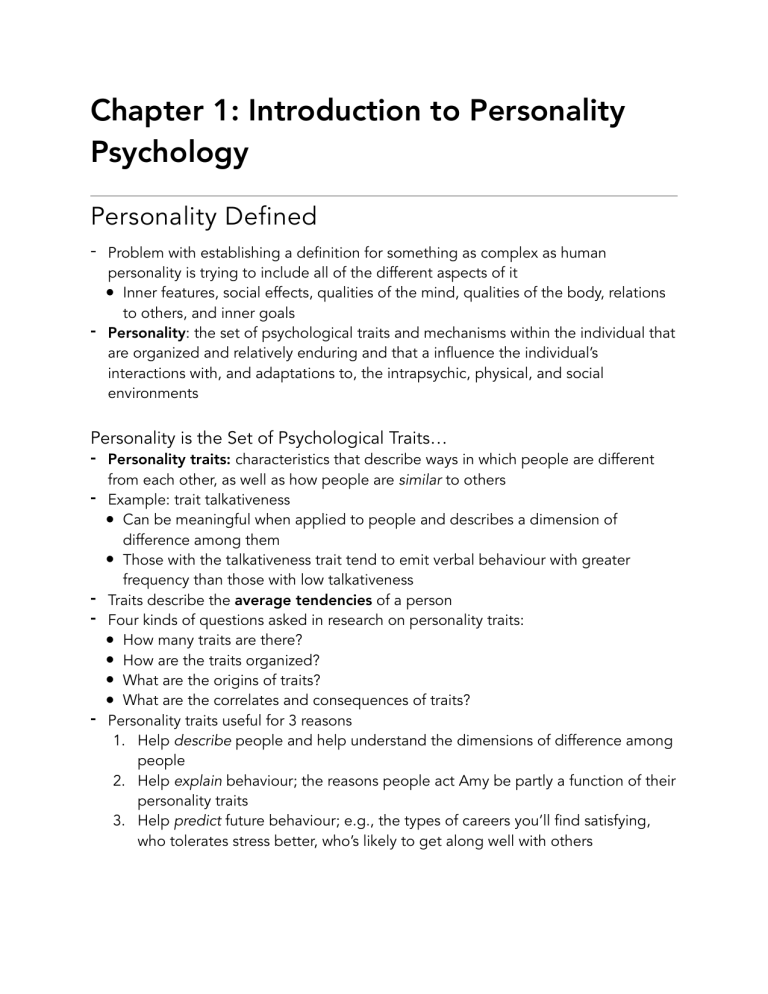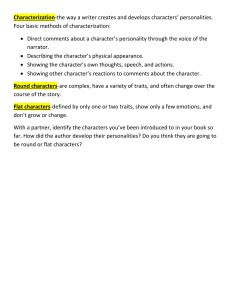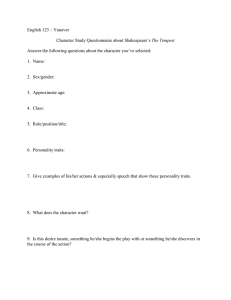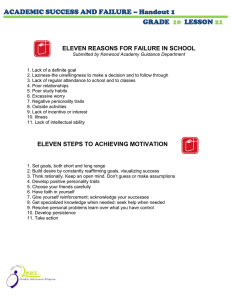
Chapter 1: Introduction to Personality Psychology Personality Defined - Problem with establishing a definition for something as complex as human - personality is trying to include all of the different aspects of it • Inner features, social effects, qualities of the mind, qualities of the body, relations to others, and inner goals Personality: the set of psychological traits and mechanisms within the individual that are organized and relatively enduring and that a influence the individual’s interactions with, and adaptations to, the intrapsychic, physical, and social environments Personality is the Set of Psychological Traits… - Personality traits: characteristics that describe ways in which people are different - - - from each other, as well as how people are similar to others Example: trait talkativeness • Can be meaningful when applied to people and describes a dimension of difference among them • Those with the talkativeness trait tend to emit verbal behaviour with greater frequency than those with low talkativeness Traits describe the average tendencies of a person Four kinds of questions asked in research on personality traits: • How many traits are there? • How are the traits organized? • What are the origins of traits? • What are the correlates and consequences of traits? Personality traits useful for 3 reasons 1. Help describe people and help understand the dimensions of difference among people 2. Help explain behaviour; the reasons people act Amy be partly a function of their personality traits 3. Help predict future behaviour; e.g., the types of careers you’ll find satisfying, who tolerates stress better, who’s likely to get along well with others And Mechanisms… - Psychological mechanisms: like traits, except term mechanisms refers more to the - - - processes of personality • E.g., most involve an information-processing activity Most psychological mechanisms have 3 essential ingredients • Inputs • Decision rules • Outputs Psychological mechanism make people more sensitive to certain kinds of information from the environment (input), may make them more likely to think about specific options (decision rules), and may guide their behaviour toward certain categories of action (outputs) • Example: Extraverted people - May look for opportunities to be with other people, may consider in each situation the possibilities for human contact and interaction, and may encourage others to interact with them - Not all of our traits and psychological mechanisms are activated at all times • e.g., courageousness - Only activated under particular conditions - Some more courageous than others, but never know which people are courageous until it presents itself Within the Individual… - Within the individual: personality is something a person carries with themselves - over time and from one situation to the next Typically feel today we’re the same people we were last week, month, year Continue to have personalities into the coming months and years Personalities are influenced by our environments, we carry the same personalities from situation to situation Important sources of personality reside within the individual, and are at least somewhat stable over time and somewhat consistent over situations That are Organized and Relatively Enduring - Organized: the psychological traits and mechanisms for a given person aren’t a - - random collection of elements • Personality is organized because the mechanisms are linked to one another in a coherent fashion • They contain decision rules that govern which needs are activated, depending on the circumstances Enduring over time, particularly in adulthood, and somewhat consistent over situations • e.g., person may be angry now in this situation but not tomorrow or in others - Anger is a state not a trait - Saying someone is anger prone is describing a psychological trait - Someone who’s anger prone is frequently angry, and shows this proneness multiple times in different situations Some situations may be overpowering and suppress the expression of psychological traits and this consistency may not hold • e.g., someone talkative might remain quiet during a lecture And That Influence… - Influential forces of personality means that personality traits and mechanisms can - - have an effect on people’s lives Personality influences how we act, view ourselves, think about the world, interact with others, how we feel, how we select our environments (particularly social environments), what goals and desires we pursue ini life, and how we react to other circumstances Personality plays a key role in affecting how people shape their lives Traits are forces that influence how we think, act, and feel The Individual’s Interactions with… - Most difficult to describe because the nature of person-environment interaction is complex - Interactions with situations include perceptions, selection, evocations, and manipulations - Perceptions - how we “see,” or interpret, an environment • Two people may be exposed to the same objective event, yet what they pay - attention to and how they interpret the event may be very different • Difference is a function of their personalities • e.g., inkblots Selection - describes the manner in which we choose situations to enter • How we choose our friends, hobbies, university or college classes, careers • How we go about making these selections is (in part) a reflection of our - - - personalities • e.g., how we use our free time Evocations - the reactions we produce in others, often unintentionally • To some extent, we create the social environments we inhibit • e.g., a physically large person may evoke feelings of intimidation onto others, even if intimidation isn’t the goal • Our evocative interactions are essential features of our personalities Manipulations - the ways in which we intentionally attempt to influence others • e.g., someone who’s anxious or frightened easily may try to influence their group to avoid scary movies or risky activities • The ways in which we attempt to manipulate the behaviour, thoughts, and feelings of others are essential features of our personalities These forms of interaction are central to understanding the connections between the personalities of people and the environments they inhabit And Adaptations to… - Emphasis on adaptations conveys the notion that a central feature of personality - concerns adaptive functioning - accomplishing goals, coping, adjusting, and dealing with the challenges and problems we face as we go through life Human behaviour is goal directed, functional, and purposeful Behaviour that doesn’t appear functional (e.g., excessive worrying) may in fact, be functional Some aspects of personality processes represent deficits ion normal adaptations, such as breakdowns in ability to cope with stress, regulate one’s social behaviour, or manage one’s emotions The Environment - Physical environment often poses challenges for people - Some are direct threats to survival • e.g., food shortages create problem of securing adequate nutrients for survival - Humans have evolved solutions to these adaptive problems • e.g., Shivering mechanisms help combat the cold, sweat glands help fight the - heat At psychological level, our fears of heights, snakes, spiders, and strangers help us avoid or safely interact with these environmental threats to our survival Social environment poses adaptive challenges • e.g., Desire the prestige of a good job, but there’s many other people competing for the same positions - The ways we cope with our social environment (challenges we encounter in our - - - struggle for belongingness, love, and esteem- are central to an understanding of personality Particular aspect of the environment important at any moment in time is frequently determined by personality • e.g., person who is talkative will notice more opportunities in the social environment to strike up conversations than will someone low on talkativeness From the infinite dimensions of the environment we inhabit, our “effective environment” represents only the small subset of features that our psychological mechanisms direct us to attend and respond to Have an intrapsychic environment Intrapsychic means “within the mind” • We have memories, dreams, desires, and a collection of private experiences we live with each day Intrapsychic environment not objectively verifiable as social or physical but makes up an important part of our psychological reality • e.g., self-esteem may depend on our assessment of the degree to which we are succeeding in attaining our goals Success at work and success at friendship provide 2 different forms of success and experience and form different intrapsychic memories Three Levels of Personality Analysis - Personality can be analyzed at three levels - 1. Like all others (human nature level) 2. Like some others (level of individual and group differences) 3. Like no others (individual uniqueness level) First level refers to “universals” • Ways in which we’re all alike Middle level refers to “particulars • Ways in which we’re like some people but unlike others) Third level refers to “uniqueness” • Ways in which we’re unlike any other person) /





